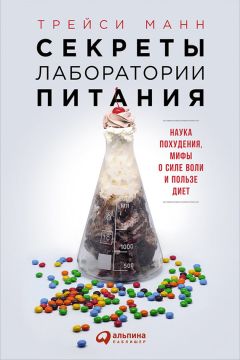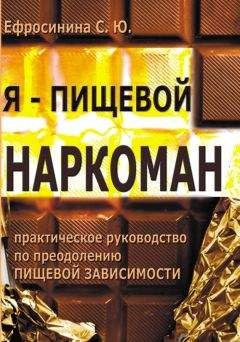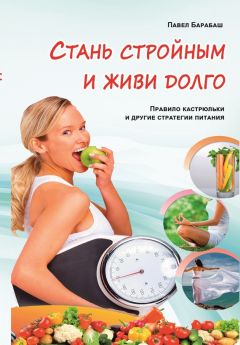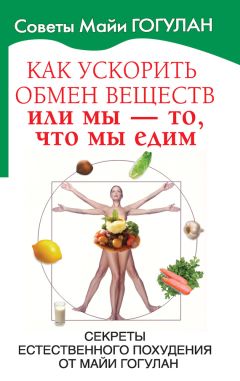Трейси Манн - Секреты лаборатории питания. Наука похудения, мифы о силе воли и пользе диет
37. Liddle, “If We Don’t Stigmatise Fat People, There’ll Be Lots More of Them”.
38. Brenda Major et al., “The Ironic Effects of Weight Stigma”, Journal of Experimental Social Psychology 51 (March 2014): 74-80, doi:10.1016/j. jesp.2013.11.009.
39. Подтверждают это и другие эксперименты. См.: Elizabeth А. Pascoe and Laura Smart Richman, “Effect of Discrimination on Food Decisions”, Self and Identity 10, no. 3 (July 2011): 396-406, doi: 10.1080/15298868.2010.526384; Natasha A. Schvey, Rebecca M. Puhl, and Kelly D. Brownell, “The Impact of Weight Stigma on Caloric Consumption”, Obesity (Silver Spring, MD) 19, no. 10 (October 2011): 1957-62, doi:10.1038/oby.2011.204; Rebecca Puhl, Joerg Luedicke, and Jamie Lee Peterson, “Public Reactions to Obesity-Related Health Campaigns: A Randomized Controlled Trial”, American Journal of Preventive Medicine 45, no. 1 (July 1, 2013): 36-48, doi:10.1016/j. amepre.2013.02.010.
40. Lenny R. Vartanian and Sarah A. Novak, “Internalized Societal Attitudes Moderate the Impact of Weight Stigma on Avoidance of Exercise”, Obesity (Silver Spring, MD) 19, no. 4 (April 2011): 757-62, doi:10.1038/oby.2010.234; Lenny R. Vartanian and Jacqueline G. Shaprow, “Effects of Weight Stigma on Exercise Motivation and Behavior: A Preliminary Investigation among College-Aged Females”, Journal of Health Psychology 13, no. 1 (January 1, 2008): 131-38, doi: 10.1177/1359105307084318.
41. Jason D. Seacat and Kristin D. Mickelson, “Stereotype Threat and the Exercise / Dietary Health Intentions of Overweight Women”, Journal of Health Psychology 14, no. 4 (May 1, 2009): 556-67, doi: 10.1177/1359105309103575.
42. Vartanian and Shaprow, “Effects of Weight Stigma on Exercise Motivation and Behavior”; Vartanian and Novak, “Internalized Societal Attitudes Moderate the Impact of Weight Stigma on Avoidance of Exercise”.
43. Чисто технически это предотвращало ожидаемое понижение уровня кортизола. Schvey, Puhl, and Brownell, “The Stress of Stigma”. См. также: Tomiyama et al., “Associations of Weight Stigma with Cortisol and Oxidative Stress Independent of Adiposity”.
44. Полным актерам достается лишь 5% главных ролей в телешоу, а для съемок в фильме не считается обязательным заключать с ними контракт. Bradley S. Greenberg et al., “Portrayals of Overweight and Obese Individuals on Commercial Television”, American Journal of Public Health 93, no. 8 (August 10, 2003): 1342^8, doi: 10.2105/ AJPH.93.8.1342.
45. Jeffrey M. Hunger and A. Janet Tomiyama, “Weight Labeling and Obesity”, JAMA Pediatrics (April 28, 2014), doi: 10.1001/ jamapediatrics.2014.122. Статистические данные о взрослых см. в работе: Angelina R. Sutin and Antonio Terracciano, “Perceived Weight Discrimination and Obesity”, ed. Robert L. Newton, PloS One 8, no. 7 (January 2013): e70048, doi:10.1371/journal.pone.0070048.
46. Flegal et al., “Prevalence of Obesity and Trends in the Distribution of Body Mass Index among US Adults, 1999-2010”.
47. Tatiana Andreyeva, Rebecca M. Puhl, and Kelly D. Brownell, “Changes in Perceived Weight Discrimination among Americans, 1995-1996 through 2004-2006”, Obesity (Silver Spring, MD) 16, no. 5 (May 2008): 1129-34, doi: 10.1038/oby.2008.35.
48. Gordon W. Allport, “The Nature of Prejudice” (Reading, MA: Addison-Wesley, 1954). Для ознакомления с характерным примером гомофобии см.: Sebastian Е. Barto, Israel Berger, and Peter Hegarty, “Interventions to Reduce Sexual Prejudice: A Study-Space Analysis and Meta-Analytic Review”, Journal of Sex Research 51, no. 4 (January 2014): 363-82, doi:10.1080/00224499.2013.871625.
49. S. S. Wang, K. D. Brownell, and T. A. Wadden, “The Influence of the Stigma of Obesity on Overweight Individuals”, International Journal of Obesity and Related Metabolic Disorders 28, no. 10 (October 1, 2004): 1333-7, doi:10.1038/sj.ijo.0802730.
50. Tracy Moore, “I Don’t Love (or Hate) My Body — and So Can You!”, Jezebel.com, 2014, http://jezebel.com/i-dont-love-or-hate-my-body-and-so-can-you-1557099034.
51. Joan Jacobs Brumberg, “The Body Project: An Intimate History of American Girls” (New York: Vintage Books, 1998).
52. Там же.
53. “Gym, Health & Fitness Clubs in the US: Market Research Report”, IBISWorld.com, 2014, http://www.ibisworld.com/industry/default. aspx?indid=1655.
54. Se-Jin Lee, “Regulation of Muscle Mass by Myostatin”, Annual Review of Cell and Developmental Biology 20 (January 8, 2004): 61-86, doi: 10.1146/annurev.cellbio.20.012103.135836.
55. Frank Bruni, “These Wretched Vessels”, New York Times, December 24, 2012.
ГЛАВА 12. О РЕАЛЬНЫХ ПРИЧИНАХ НЕОБХОДИМОСТИ ФИЗИЧЕСКИХ УПРАЖНЕНИЙ И О ФОРМИРОВАНИИ ПРИВЫЧКИ К НИМ1. Четкая позиция по данному вопросу сформулирована в работе: Amy Luke and Richard S. Cooper, “Physical Activity Does Not Influence Obesity Risk: Time to Clarify the Public Health Message”, International Journal of Epidemiology 42, no. 6 (December 1, 2013): 1831-36, doi:10.1093/ije/dytl59. Для ознакомления с противоположной точкой зрения см.: James О. Hill and John С. Peters, “Commentary: Physical Activity and Weight Control”, International Journal of Epidemiology 42, no. 6 (December 1, 2013): 1840-42, doi: 10.1093/ije/dytl61.
2. Один из девяти фактов об ожирении, представленных в работе: Casazza et al., “Myths, Presumptions, and Facts about Obesity”.
3. Petra Stiegler and Adam Cunliffe, “The Role of Diet and Exercise for the Maintenance of Fat-Free Mass and Resting Metabolic Rate during
Weight Loss”, Sports Medicine (Auckland, NZ) 36, no. 3 (January 2006): 239-62.
4. N. A. King et al., “The Interaction between Exercise, Appetite, and Food Intake: Implications for Weight Control”, American Journal of Lifestyle Medicine 7, no. 4 (February 6, 2013): 265-73, doi: 10.1177/1559827613475584; Catia Martins et al., “Effects of Exercise on Gut Peptides, Energy Intake and Appetite”, Journal of Endocrinology 193, no. 2 (May 1, 2007): 251-58, doi:10.1677/JOE-06-0030.
5. Carolina О. C. Werle, Brian Wansink, and Collin R. Payne, “Just Thinking about Exercise Makes Me Serve More Food: Physical Activity and Calorie Compensation”, Appetite 56, no. 2 (April 2011): 332-35, doi: 10.1016/j.appet.2010.12.016.
6. 150 минут тренировок средней интенсивности (или 75 минут тренировок высокой интенсивности) в неделю рекомендованы для поддержания здоровья, для похудения же надо заниматься спортом по 300 минут в неделю при средней интенсивности (или по 150 при высокой). U.S. Department of Health and Human Services, “2008 Physical Activity Guidelines for Americans”, http://www.health. gov/paguidelines/.
7. Этот вывод следует из анализа 80 экспериментов, в которых участвовало более миллиона человек. Примерно в половине исследований особое внимание уделялось контролю массы тела. Guenther Samitz, Matthias Egger, and Marcel Zwahlen, “Domains of Physical Activity and All-Cause Mortality: Systematic Review and Dose-Response Meta-Analysis of Cohort Studies”, International Journal of Epidemiology 40, no. 5 (October 1, 2011): 1382-400, doi:10.1093/ije/dyrll2.
8. За больными наблюдали более восьми лет. Edward W. Gregg et al., “Relationship of Walking to Mortality among US Adults with Diabetes”, Archives of Internal Medicine 163, no. 12 (June 23, 2003): 1440-7, doi:10.1001/archinte.l63.12.1440.
9. Samitz, Egger, and Zwahlen, “Domains of Physical Activity and All-Cause Mortality”.
10. Huseyin Naci and John P. A. Ioannidis, “Comparative Effectiveness of Exercise and Drug Interventions on Mortality Outcomes: Metaepidemiological Study”, BMJ (Clinical Research Ed.) 347 (January 2013): f5577.
11. Там же.
12. Mark Hamer, Kim L. Lavoie, and Simon L. Bacon, “Taking Up Physical Activity in Later Life and Healthy Ageing: The English Longitudinal Study of Ageing”, British Journal of Sports Medicine 48, no. 3 (February 1, 2014): 239-43, doi:10.1136/bjsports-2013-092993.
13. Francesco Sofi et al., “Physical Activity during Leisure Time and Primary Prevention of Coronary Heart Disease: An Updated Meta-Analysis of Cohort Studies”, European Journal of Cardiovascular Prevention and Rehabilitation 15, no. 3 (June 1, 2008): 247-57, doi: 10.1097/ HJR.0b013e3282f232ac.
14. Chong Do Lee, Aaron R. Folsom, and Steven N. Blair, “Physical Activity and Stroke Risk: A Meta-Analysis”, Stroke 34, no. 10 (October 1, 2003): 2475-81, doi:10.1161/01.STR.0000091843.02517.9D.
15. Frank B. Hu et al., “Walking Compared with Vigorous Physical Activity and Risk of Type 2 Diabetes in Women”, JAMA 282, no. 15 (October 20,1999): 1433, doi:10.1001/jama.282.15.1433; S. P. Helmrich et al., “Physical Activity and Reduced Occurrence of Non-Insulin-Dependent Diabetes Mellitus”, New England Journal of Medicine 325, no. 3 (July 18, 1991): 147-52, doi:10.1056/NEJM199107183250302; Bridget M. Kuehn, “Physical Activity May Stave Off Diabetes for Women at Risk”, JAMA(dec63) 311, no. 22 (June 11, 2014): 2263, doi:10.1001/ jama.2014.6862.
16. Inger Thune and Anne-Sofie Furberg, “Physical Activity and Cancer Risk: Dose-Response and Cancer, All Sites and Site-Specific”, Medicine and Science in Sports and Exercise 33, Suppl. (June 1, 2001): S530-S550, doi: 10.1097/00005768-200106001-00025.
17. Это происходит, даже если масса тела не уменьшается. Sean Carroll and Mike Dudfield, “What Is the Relationship between Exercise and Metabolic Abnormalities?”, Sports Medicine 34, no. 6 (2004): 371-418, doi: 10.2165/00007256-200434060-00004.
18. Kelly M. Naugle, Roger B. Fillingim, and Joseph L. Riley, “A Meta-Analytic Review of the Hypoalgesic Effects of Exercise”, Journal of Pain 13, no. 12 (December 2012): 1139-50, doi:10.1016/j.jpain.2012.09.006.
19. Liisa Byberg et al., “Total Mortality After Changes in Leisure Time Physical Activity in 50 Year Old Men: 35 Year Follow-up of Population Based Cohort”, BMJ (Clinical Research Ed.) 338, no. mar05_2 (January 5, 2009): b688, doi: 10.1136/bmj.b688.
20. Caudwell et al., “Exercise Alone Is Not Enough”.
21. Там же.
22. Один из девяти фактов об ожирении, представленных в работе: Casazza et al., "Myths, Presumptions, and Facts about Obesity’’.
23. Petri Wiklutul cl nl., "Metabolic Response to 6-Week Aerobic Exercise Training and Dieting in Previously Sedentary Overweight and Obese Pre-Menopmisnl Women: Л Randomized Trial”, Journal of Sport and Health Science (.June 2014), doi: 10.1016/j.jshs.2014.03.013.
24. Organisation lor Economic Co-operation and Development Better Life Index, 2014, Center lor Economic and Policy Research, http://www. cepr.net/index.php/piiblications/reports/no-vacation-nation-2013.
25. Rebecca Ray, Milla Stines, and John Schmitt, “No-Vacation Nation Revisited” (Washington, DC: Center for Economic and Policy Research, 2013).
26. Главные доказательства пагубного воздействия стресса на здоровье собраны п грамотно и хорошо написанной книге: Robert Sapolsky, "Why Zebras Don’t Get Ulcers”, 3rd.ed. (New York: Holt Paperbacks, 2004). J[m ознакомления с классическим научным обзором см.: McEwen and Seeman, “Protective and Damaging Effects of Mediators of Stress”.
27. Хороший тому пример — эксперименты с прыжками с парашютом. Подробнее см.: Manfred Schedlowski et al., “Changes of Natural Killer Cells during Acute Psychological Stress”, Journal of Clinical Immunology 13, no. 2 (March 1993): 119-26, doi:10.1007/BF00919268.
28. S. Cohen, D. Janicki-Deverts, and G. E. Miller, “Psychological Stress and Disease”, JAMA 298, no. 14 (2007): 1685-87, doi:10.1001/ jama.298.14.1685.
29. Sapolsky, “Why Zebras Don’t Get Ulcers”.
30. Там же.
31. Там же.
32. Sally S. Dickerson and Margaret E. Kemeny, “Acute Stressors and Cortisol Responses: A Theoretical Integration and Synthesis of Laboratory Research”, Psychological Bulletin 130, no. 3 (May 1, 2004): 355-91, doi: 10.1037/0033-2909.130.3.355; Gregory E. Miller, Edith Chen, and Eric S. Zhou, “If It Goes Up, Must It Come Down? Chronic Stress and the Hypothalamic-Pituitary-Adrenocortical Axis in Humans”, Psychological Bulletin 133, no. 1 (2007): 25-45.
33. P. Bjorntorp, “Do Stress Reactions Cause Abdominal Obesity and Comorbidities?”, Obesity Reviews 2, no. 2 (May 2001): 73-86, doi:10.1046/j.l467 789x. 2001.00027.x; E. S. Epel et al., “Stress and Body Shape: Stress-Induced Cortisol Secretion Is Consistently Greater among Women with Central Fat”, Psychosomatic Medicine 62, no. 5 (2000): 623-32.
34. Suzanne C. Segerstrom and Gregory E. Miller, “Psychological Stress and the Human Immune System: A Meta-Analytic Study of 30 Years of Inquiry”, Psychological Bulletin 130, no. 4 (July 1, 2004): 601-30, doi: 10.1037/0033-2909.130.4.601; Theodore F. Robles, Ronald Glaser, and Janice K. Kiecolt-Glaser, “Out of Balance. A New Look at Chronic Stress, Depression, and Immunity”, Current Directions in Psychological Science 14, no. 2 (April 2005): 111-15, doi:10.1111/ j.0963-7214.2005.00345.x; Schedlowski et al., “Changes of Natural Killer Cells during Acute Psychological Stress”.
35. Sheldon Cohen, David A. Tyrrell, and Andrew P. Smith, “Psychological Stress and Susceptibility to the Common Cold”, New England Journal of Medicine 325, no. 9 (1991): 606-12.
36. Jessica Walburn et al., “Psychological Stress and Wound Healing in Humans: A Systematic Review and Meta-Analysis”, Journal of Psychosomatic Research 67, no. 3 (September 2009): 253-71, doi: 10.1016/j.jpsychores.2009.04.002.




